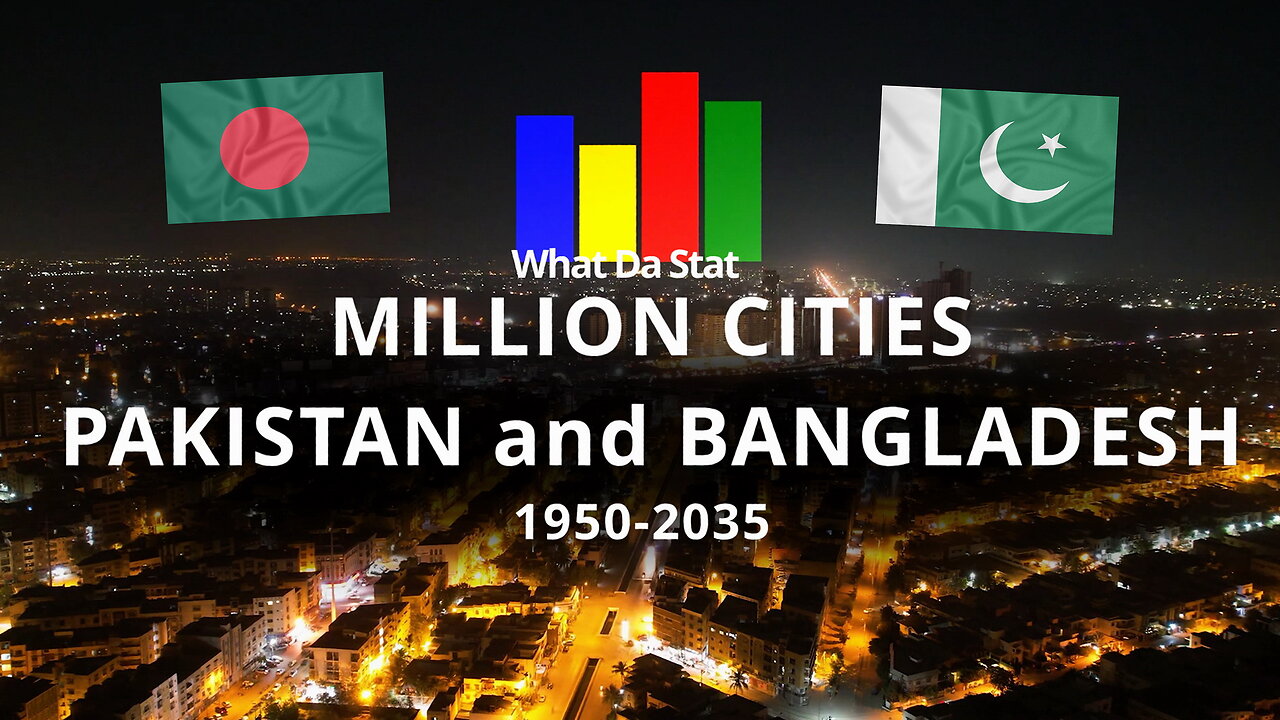Premium Only Content

Million Cities in Pakistan and Bangladesh 1950-2035
This bar chart race shows urban agglomerations in Pakistan and Bangladesh/East Pakistan/East Bengal with over one million urban population, and urbanization in percentage and total urban population, from 1950 to projected in 2035.
Bangladesh declared independence in 1971 from Pakistan. Until 1955 was East Bengal, and from 1955 until 1971 it was East Pakistan.
Pakistan
Urbanization in Pakistan has rapidly increased since 1950 due to industrialization, migration, and natural population growth. The country now has several large urban agglomerations, with Karachi, Lahore, and Faisalabad being the most prominent.
Karachi:
As the largest city in Pakistan, Karachi has experienced explosive growth since the 1950s due to its status as the country's economic hub and port city. Its population grew from around 1 million in 1950 to over 15 million today. Karachi is a center of finance, industry, and trade.
Lahore:
The second-largest city, Lahore, is Pakistan's cultural and historical capital. Its population has expanded from around 850,000 in 1951 to over 11 million. The city's economy is diverse, with strong sectors in education, services, and manufacturing.
Faisalabad:
Faisalabad, known as the industrial heart of Pakistan, has grown from a small town into a major city, particularly due to its textile industry. Its population exceeds 3.5 million today.
Other major cities:
Rawalpindi, Multan, Peshawar, and Gujranwala have also crossed the 1 million mark. Rawalpindi and Islamabad (the capital) together form a significant urban area.
Bangladesh/East Pakistan (East Bengal)
Bangladesh, previously East Pakistan (until 1971), has also experienced significant urban growth. Dhaka is the most prominent urban agglomeration, followed by Chittagong and other emerging cities.
Dhaka:
Dhaka, the capital, has seen rapid growth since the 1950s due to migration, particularly rural-to-urban migration. In 1950, Dhaka had around 400,000 people; now, it exceeds 22 million, making it one of the largest cities in the world. It is the economic and political center of Bangladesh.
Chittagong:
Chittagong, a major port city and industrial hub, has grown from a population of around 300,000 in the 1950s to over 5 million today. It is critical for the country's export-oriented industries.
Other cities:
Sylhet, Khulna, and Rajshahi have emerged as secondary urban centers, each with populations over 1 million. These cities are growing due to regional industries and remittance-driven development.
Urbanization Trends Since 1950
Pakistan:
Rapid urban growth: Urbanization in Pakistan increased from about 17% in 1951 to over 37% today. Karachi and Lahore have been primary destinations for rural migrants, creating sprawling urban centers with significant infrastructure challenges.
Push and pull factors: Industrialization, better employment opportunities, and conflict in rural areas have driven migration. Cities like Karachi have faced severe pressure on housing, transportation, and public services.
Bangladesh:
Accelerating urbanization: In Bangladesh, urbanization was slower initially but has picked up since the 1980s. The urban population increased from 4% in 1950 to over 35% today, with Dhaka absorbing much of this growth. The country’s urban centers, particularly Dhaka, are characterized by informal settlements due to inadequate housing for migrants.
Economic migration: Rural poverty and frequent flooding have pushed people toward cities, where they seek employment in industries such as garments and manufacturing.
Challenges of Urbanization:
Infrastructure: Both countries struggle with insufficient infrastructure to cope with rapid urban growth. In cities like Karachi and Dhaka, issues like traffic congestion, pollution, and inadequate housing are prominent.
Employment and services: The demand for jobs, healthcare, and education has outpaced the development of urban services. Informal economies are a significant part of these urban centers.
Environmental concerns: Overcrowded cities, especially coastal ones like Karachi and Chittagong, face environmental hazards such as flooding, water shortages, and pollution.
In conclusion, urban agglomerations in Pakistan and Bangladesh have expanded dramatically since 1950, fueled by economic opportunities and migration. However, both countries face challenges related to infrastructure, services, and sustainable urban growth.
Data sources and projections: World Bank and UN
Music: Stellardrone - Billions And Billions https://soundcloud.com/stellardrone/stellardrone-02-billions-and
Billions And Billions By Stellardrone is licensed under a Creative Commons License.
Data visualization created with flourish.studio https://flourish.studio
-
 1:38:10
1:38:10
The Quartering
2 hours agoKash Patel "Discovers" Secret FBI Files On Trump, NYC Shooter New Conspiracy, Planned Parenthood
102K16 -
 LIVE
LIVE
Pop Culture Crisis
1 hour agoOprah Tsunami BACKLASH, Billie Eilish RACIST? Joey Swoll BENDS THE KNEE | Ep. 888
443 watching -
 LIVE
LIVE
Crypto Power Hour
2 hours ago $0.75 earnedSmart Contracts On The Blockchain
119 watching -
 1:00:03
1:00:03
Russell Brand
4 hours agoRand Paul: Trump, Tariffs & The Tyranny of Centralized Power - SF623
129K101 -
 9:01
9:01
Dr. Nick Zyrowski
1 month agoThe BIG NAC ( N-Acetyl Cysteine) Mistake
9.57K9 -
 2:12:44
2:12:44
Tucker Carlson
4 hours agoJohn Mearsheimer: The Palestinian Genocide and How the West Has Been Deceived Into Supporting It
70.8K92 -
 39:30
39:30
The White House
3 hours agoPresident Trump Signs Congressional Bill, July 30, 2025
22.3K19 -
 LIVE
LIVE
GritsGG
7 hours agoWin Streaking All Day! Most Wins 3215+!
63 watching -
 1:10:52
1:10:52
Sean Unpaved
3 hours agoGameplan & Glam: Sanders' Reps Snub, NFC North Heatwave, MLB Deadline Surge, Sweeney's Eagle Glow
24.4K -
 3:52
3:52
Michael Heaver
11 hours agoPanicked Labour Now Completely IMPLODING
21.7K4